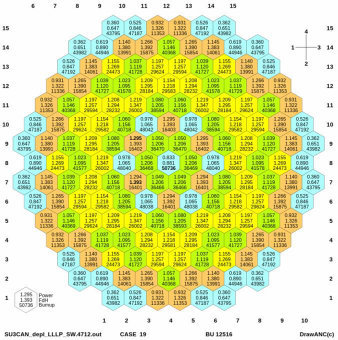Background
Westinghouse core design and safety analysis capabilities for VVER reactors lead to customer success in multiple areas. Examples include fuel and core designs, supporting power uprate projects, plant optimization projects, design reconstitution, modernization projects, safety upgrades, cycle-specific analyses, fuel licensing calculations and operational support.
The methods and methodologies applied for VVER reactors are based on proven, existing Westinghouse tools used in PWR applications for decades and adjusted to effectively model the differences caused by the hexagonal VVER design.
Description and Benefits
Westinghouse VVER core design and safety analyses specific functional capabilities include methods and methodologies for neutronic- and thermal-hydraulic calculations, fuel rod design, Loss Of Coolant Accident (LOCA), and non-LOCA analyses as approved by the U.S. Nuclear Regulatory Commission (NRC) and other international regulatory authorities. The tools are continuously used for modeling multiple fuel products and analyzing homogenous and mixed cores.
The standard tool for VVER core design is the advanced APA-H (ALPHA-H, PHOENIX-H, and ANC-H) code system evolved from the well-known and time-proven APA nuclear design code system. APA-H is a flexible tool that can be used for all nuclear design and steady-state safety related calculations and analyses for all VVER cores including VVER-440, VVER-1000 and all newer designs such as VVER-1200, VVER-1500 and VVER-TOI.
The Westinghouse VVER thermal-hydraulic (TH) technology includes the sub-channel code VIPRE-W and, Departure from Nucleate Boiling (DNB) correlations for advanced fuel designs. To improve DNB analysis accuracy and for improved DNB margins, Westinghouse has specifically developed empirical DNB correlations for VVER fuel designs containing grid spacers with- or without mixing vanes. For example, the use of the WVHI DNB correlation, for non-mixing vane fuel allows increasing the core design power peaking factor limit by three percent without any restrictions and without changing the plant safety analysis of record. Additional DNB margin can be gained with Westinghouse TH statistical design procedures which provide an improved methodology for uncertainty treatment of reactor core and fuel design parameters.
The Westinghouse methodologies and computer codes WCOBRA/TRAC and NOTRUMP/LOCTA-IV employed to perform LOCA analyses are flexible and able to address VVER-1000 unique design features such as horizontal steam generators, combined Emergency Core Cooling System (ECCS) injection to upper plenum, downcomer, and cold legs and hexagonal lattice fuel assembly.
Three principal computer codes are used in the transient analysis of non-LOCA events for a VVER core: LOFTRAN, FACTRAN, and TWINKLE. These codes are standard tools to analyze non-LOCA events in PWR applications and they have been reviewed and approved by the NRC for safety analysis use.
The non-LOCA codes have been modified to specifically address some particular characteristics of the VVER-1000, design like the triangular fuel lattice geometry and annular pellets, and to simulate the behavior of some typical VVER-1000 reactor protection signals.
Computer Codes
ALPHA-H is the user input preprocessor and the sequence controller designed to automate all PHOENIX-H models, and transfer cross section data to ANC-H.
PHOENIX-H is a two-dimensional multigroup transport theory code used for calculating the physics characteristics of hexagonal assemblies of VVER cores.
ANC-H is a three-dimensional nodal code for VVER cores evolving from the NRC licensed Advanced Nodal Code (ANC) for square-lattice core applications. ANC-H has the capability to perform nuclear core design calculations including predictions of core reactivity, assembly power, rod power, and reactivity coefficients. ANC-H is also used in the BEACON™ system in conjunction with the self-powered neutron detectors to perform power distribution monitoring and surveillance during plant operation.
VIPRE-W is the main Westinghouse tool to analyze margin to DNB in terms of DNB ratio (DNBR) in the TH analysis of VVER cores. VIPRE-W is the Westinghouse version of the Electric Power Research Institute (EPRI) VIPRE-01 subchannel code. VIPRE-W contains features for PWR and VVER licensing applications such as DNB correlations specifically developed for VVER-1000 applications including the WX1-H/WX1-L correlations for grids with mixing vanes and the WVHI/WVLO correlations for grids without mixing vanes. The correlations are applicable to VVER design conditions including reduced loop operation.
WCOBRA/TRAC is a thermal-hydraulic computer code that is used to provide a best-estimate calculation of realistic fluid conditions during blowdown and reflooding for a Large Break LOCA event.
NOTRUMP/LOCTA-IV analyzes the thermal-hydraulic behavior of LOCAs with sizes up to a break area of 0.1 m2. NOTRUMP is an advanced thermal-hydraulic code, while the detailed calculations of the fuel and cladding responses during a LOCA are carried out by LOCTA-IV.
The LOFTRAN code is used to analyze the great majority of the non-LOCA events. LOFTRAN simulates a multi-loop system containing a reactor vessel, hot- and cold -leg piping, steam generator tube and shell side, and pressurizer. The core simulation is based on point neutron kinetics and the reactor control systems, engineered safety features and reactor protection system are also simulated.
FACTRAN is a digital computer code that calculates the transient temperature distribution in a cross-section of a metal-clad UO2 fuel rod and the heat flux at the surface of the cladding, using as input the nuclear power and the local pressure, flow, and temperature conditions of the coolant.
The TWINKLE code is used to predict the kinetic behavior of a reactor for transients that cause a major perturbation in the spatial neutron flux distribution, such as the rod withdrawal from subcritical and rod ejection events.
Experience
Westinghouse PWR core design and safety analysis methods and methodologies are used extensively for plants in several countries. The code modifications for application to VVER plants have been qualified through calculations in accordance with the NRC accepted Westinghouse Quality Assurance Program and have been reviewed and accepted by Regulators in Czech Republic and Ukraine. The codes for VVER reactors have been used for licensing of Westinghouse-supplied VVER-1000 fuel to nuclear power plants in Ukraine and the Czech Republic.
Moreover, the NRC approved Westinghouse’s reload analysis process adjusted for VVER-specific aspects, has been implemented in Czech Republic and Ukraine and successfully used for reload core design for reactor cores containing Westinghouse VVER-1000 fuel.


